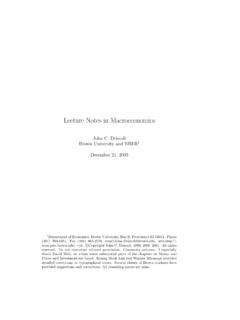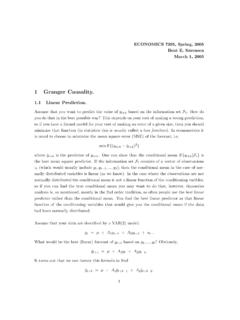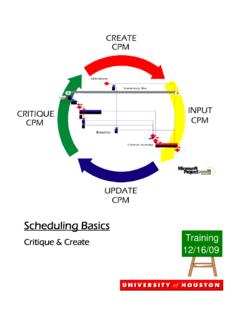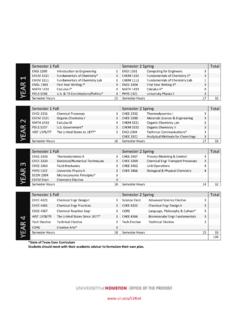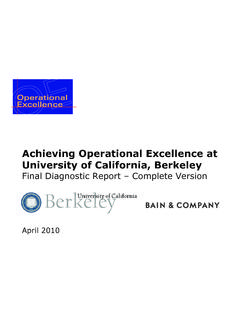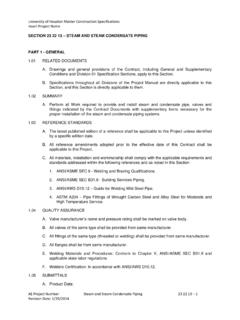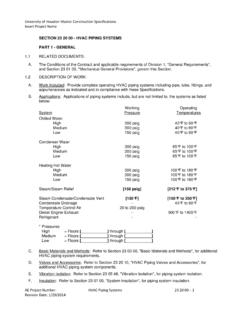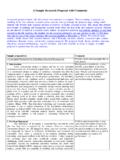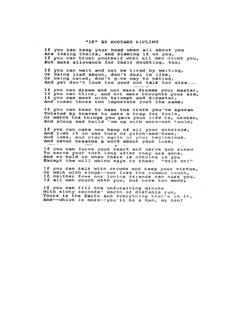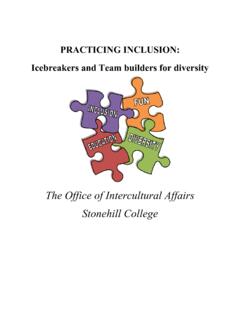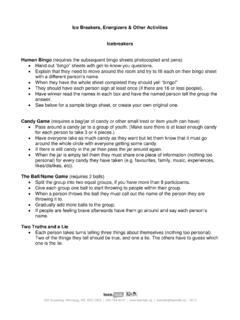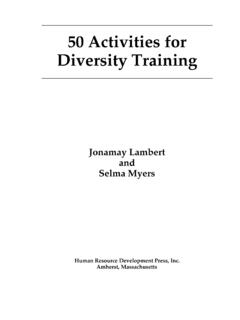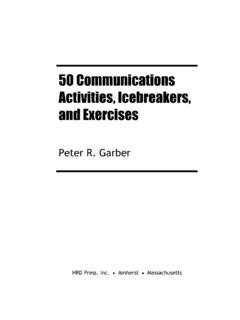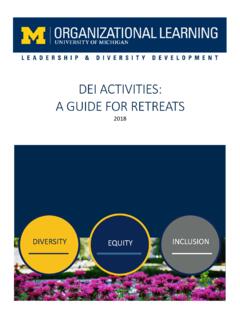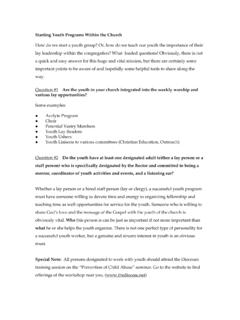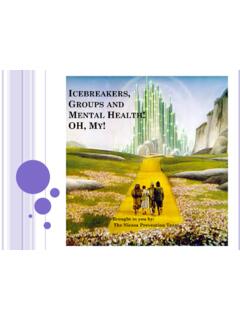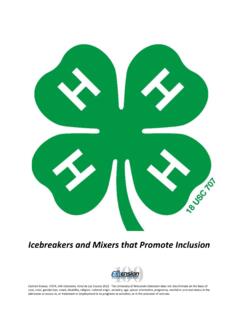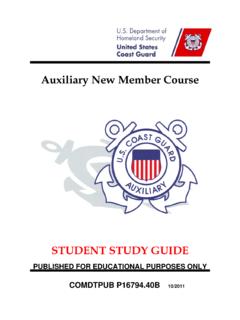Transcription of Diversity and Inclusion Activities
1 This worksheet is part of a curated selection of Diversity , Equity and Inclusion exercises maintained by the UH Center for Diversity and Inclusion . It is intended to provide an engaging, hands-on activity that allows participants to gain a greater understanding of Diversity , Equity and Inclusion topics. Office of Human Resources Diversity & Inclusion Activities Diversity and Inclusion Activities are simple ways to get people talking and listening to one another. It is only through understanding each other that we truly gain knowledge and can move forward together. While we can't always walk in someone else's shoes, we can take the time to inquire about how the shoe fits and if its path is smooth or riddled with pebbles. Social Justice PO Box 6031, 412 Knapp Hall Morgantown, WV 26506 304-293-8948. Office of Human Resources Objectives There are many reasons you may choose to use and icebreaker or activity: to warm up or relax your group, to bring your group back together after a break or intense session, to introduce the next segment or to present your group with challenges that, as a team (together or divided into small groups or teams), your group must either overcome or address.
2 Age & Appropriateness icebreakers and Activities are adaptable to your group and situation. When considering an icebreaker or activity, be sure to keep specifics about your group in mind, such as age and meeting focus. Please don't overlook an icebreaker or activity because you think the group is too mature for it. Many groups, once aware that it's ok to relax and have fun, will enjoy the experience of being able to let go, if only for a moment. icebreakers icebreakers are exercises that are intended to help a group of people begin the process of forming and working with a team. icebreakers are commonly used at the beginning of a meeting and presented in a game format to warm up the group and help them get to know each other. However, icebreakers can be used at any point during a meeting and for many reasons: to keep the group on track; to provide the group with a mental or physical break; after lunch to get the group back into the mindset of the meeting.
3 You should not limit the use of an activity just because it is referred to as an icebreaker. When planning the use of an icebreaker, or any activity for that matter, keep your audience in mind. You don't want to inadvertently use an activity that excludes members of your group. Diversity Sometimes you will need to have a specific Diversity activity to shed light on problems you may be having, potential problems you may face or as just a refresher to help bring your group back together. Everyone should be able to feel wanted and valued during the meeting, so make sure to set ground rules before conducting any activity, including icebreakers . Diversity is not a sometimes issue that only needs to be addressed sometimes. Diversity is an always issue that needs to be cultivated, supported and reinforced. By recognizing people's similarities and differences, we can become better employees and stronger leaders.
4 In order to strengthen the sense of teamwork in the workplace, it is vital that people have an understanding of Diversity and to be able to communicate about it. In order to help people learn how to recognize and correct stereotypes, to find common ground and to be able to work with and celebrate difference within the team, open communication about Diversity must be fostered. Social Justice PO Box 6031, 412 Knapp Hall Morgantown, WV 26506 304-293-8948. I. Office of Human Resources Dividing Large Groups If you're facilitating to larger groups, you'll often want to divide them into smaller work groups. Small work groups can be very beneficial and achieve the task or goal much quicker and more efficiently. You should want to create as much of a diverse small group as you can. Generally, when the same people work together time-after-time, new results don't happen often.
5 While there are many quick and easy ways to split a group, they are generally routine and over used: counting off, splitting the room in quarters, tables working together, etc. Granted, by using these methods you achieve the goal of splitting the group, but you should question the overall outcome of the method. Have you accomplished anything beyond splitting the large group? How diverse are the small work groups? Are the same people sitting together who always sit together? Many people tend to sit with friends and the same people at each meeting so, having tables work together or splitting the room won't split the friends. Likewise, counting off may not achieve the most diverse small work group based on where people are sitting and the number you use to split them. It's important to mix the large groups in different ways because you want the group to be able to generate new ideas, problem solve and discuss issues deeply and from various viewpoints.
6 You should also want to provide the participants with the opportunity to experience different opinions, a wider range of options and to be able to really consider the positives and negatives of the issue. There will be times when you assign people to specific groups so that you can create a specific mix within the small work group. Most times, however, you will probably be able to mix the groups more freely and be able to provide a bit more fun and humor to lighten everyone up. There are many fun and easy ways to divide large groups, including: Hair color Morning, afternoon, evening people and even night owls Those wearing jewelry (by type and where (rings/bracelets can be on either hand/wrist). Types of shoes (color, strings/no strings, sandals/dress/sneakers/loafers). Birthdays (by month(s) or seasons). Coffee drinkers (regular, decaf, non).)
7 Favorite dessert/fruit (these can also be available during the meeting). Hand out candy as people enter and then separate by flavor For cynics: by what they would rather be doing (napping, playing golf, shopping, gardening, reading, hiking, family, etc.). Be creative but limit the choices by the number of groups you need. Don't be afraid to be creative or think outside of the box when separating the group. Social Justice PO Box 6031, 412 Knapp Hall Morgantown, WV 26506 304-293-8948 II. Office of Human Resources Strategies for Inclusion Communication o Without communication, strategies for creating the most inclusive atmosphere are unknown. Person-first language o Make sure to put the person first, not the disability o Say the PERSON/CHILD with a disability not disabled child . Avoid using labels o Labels are debilitating o Labels make people more aware of the difference Positively acknowledge differences o Find ways to celebrate/include differences when appropriate and possible Accessibility o Ensure that facilities are accessible to everyone o Be sure to provide reasonable accommodations Prior assessment o Make sure to assess participants' needs before they arrive o Ask for as much information as possible on registration forms to ensure that you are prepared Questions can include.
8 Do you have any dietary restrictions Do you need any special accommodations Seek help o Do not be afraid to seek help o Contact your HR or Social Justice Office for assistance Programs and Activities offered by the West Virginia University Extension Service are available to all persons without regard to race, color, sex, disability, religion, age, veteran status, political beliefs, sexual orientation, national origin, and marital or family status. West Virginia University is governed by the West Virginia Higher Education Policy Commission and the WVU Board of Governors. Trade or brand names used in this publication are for educational purposes only. The use of such product names does not imply endorsement by the WVU Extension Service to the exclusion of other products that may be equally suitable. Social Justice PO Box 6031, 412 Knapp Hall Morgantown, WV 26506 304-293-8948 III.
9 Office of Human Resources Adapting Games & Activities Games and Activities Throughout the year, games and Activities may be a part of meetings. At times, the thought of involving members with disabilities in such Activities can cause stress. This does not have to be the case. Games are one of the most versatile forms of recreation and virtually any game can be modified to accommodate a child with a disability. Some games provide physical activity while other games provide social interaction and mental exercise. Regardless of the type of games or the outcome, all games provide the setting in which an essential element of life is learned Good Sportsmanship. Good sportsmanship is useful not only in recreational Activities but also in everyday life. Through participation in games children with and without disabilities learn to: Take turns Accept boundary limits Accept defeat, lose Be eliminated according to rules Be a leader Respect the right of others Make decisions Observe rules Cooperate Get along with others Try new skills Improve old skills Informal games are games that are played with a few simple rules.
10 No one player is in the most active part for very long. This may be very desirable when participants have mental or emotional disabilities. How to Adapt Games Persons with disabilities feel more comfortable if few changes are made in an activity. Adaptations should suit ability, not disability. Encourage the youth with disabilities to suggest adaptations. In general: Substitute walking, wheeling, and rolling for running, skipping, and hopping. Use bounce, roll, or underhand toss to replace throwing, catching, and batting. Substitute sitting, kneeling, or lying down for standing. Decrease distances in such Activities as horseshoes, ring toss, and softball. Reduce the size of the playing field, court, or area. Social Justice PO Box 6031, 412 Knapp Hall Morgantown, WV 26506 304-293-8948. IV. Office of Human Resources How to Adapt Arts and Crafts Make the adaptation fit the individual.
